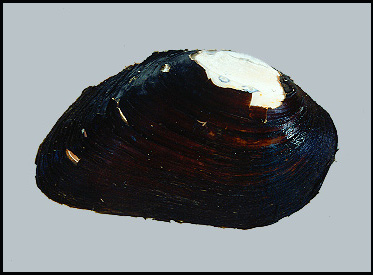Elliptio crassidens (Lamarck, 1819)

Other common names: Mule’s ear, blue ham.
Key characters: Heavy, solid, and triangular shell with dark brown to black periostracum and light purple nacre.
Similar species: Spike, mucket.
Description: Shell thick, solid, compressed to moderately inflated, triangular. Anterior end rounded, posterior end pointed. Dorsal margin slightly curved, ventral margin curved in young shells, becoming straight in older shells. Umbos low, usually not elevated above the hinge line. Beak sculpture, if visible, of two or three loops parallel to the growth lines, usually present only in very small shells. Posterior ridge prominent and sharply angled. Surface of the shell smooth. Periostracum reddish brown with faint green rays in small shells, becoming dark brown to black in adults. Length to 6 inches (15.2 cm).

Pseudocardinal teeth well developed; two in the left valve, one in the right. Lateral teeth short, roughened, and straight. Beak cavity very shallow. Nacre color variable, usually purple, occasionally pink or white.
Habitat: Large rivers in mud, sand, or fine gravel.
Status: Widespread but relatively rare in the Midwest. Locally abundant in some parts of the Ohio and White rivers of Illinois and Indiana. Endangered in Missouri, Ohio, and Wisconsin. Threatened in Illinois. Species of Special Concern in Minnesota.

